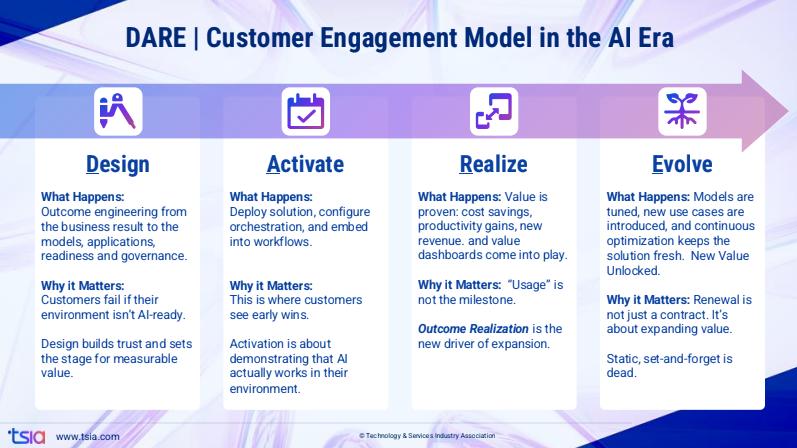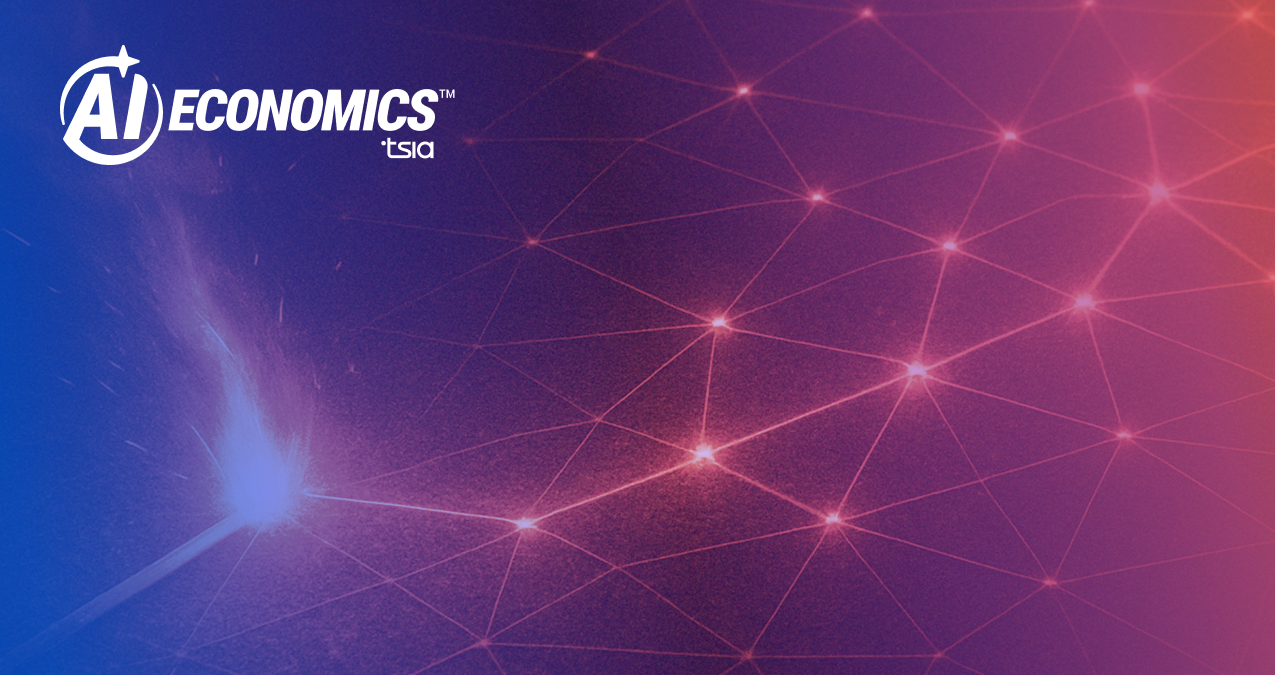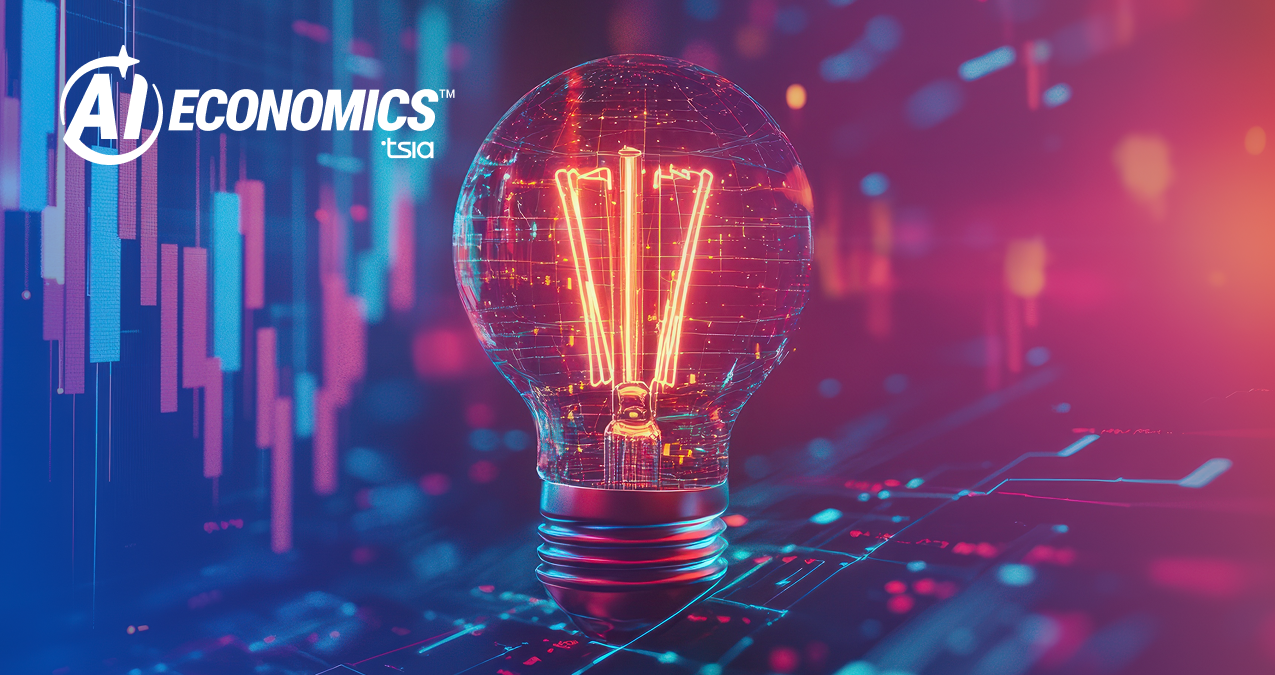On October 22, 2025, TSIA’s George Humphrey, Senior Vice President of Research, delivered one of the most provocative sessions at TSIA World ENVISION: “The Future of Technology Services: And the Irreversible Impact on Offers and Operations.”
Building on the themes of AI Economics™ introduced by Thomas Lah and J.B. Wood earlier in the week, Humphrey cut through the noise with a simple truth: "No service line is immune from the disruptions of AI." But here's what matters: that disruption isn't the end of tech services—it's the era of tech services.
Humphrey showed why serviceless AI is a myth, why per-seat pricing is dying, and why the companies that retool their services portfolios will capture AI profitability. This isn't about survival. It's about dominance.
If you're a services leader facing pressure to cut budgets or an executive making existential calls on your business model, Humphrey's session is required viewing. Because the decision you make now—cut services or retool them—will determine whether your company leads in the AI economy or becomes a footnote.
Key Takeaways
- AI is creating three new service categories that will define the next generation of technology portfolios.
- Traditional service lines are being redefined, not replaced, as companies move from reactive to predictive, manual to automated, and project-based to outcome-based delivery.
- Future-ready organizations will break silos and rebuild around value, outcomes, and continuous optimization.
A New Era for Technology Services
AI isn't a side initiative anymore—it's the foundation of enterprise value. As Humphrey put it, we're entering "an incredibly rich era for services"—but only for companies willing to retool.
The old playbook is dead. Per-seat pricing is collapsing. Product value is rising while revenue under legacy models is falling. The winners won't be the ones with the best AI—they'll be the ones who redesign their services to bridge AI capability to customer outcomes.
At the center of this shift are three new service categories that define how companies capture profitability in the AI economy.
1. AI Readiness and Governance Services (ARGS)
Most customers still don’t know where to begin when it comes to deploying AI—or whether they’re even ready. Humphrey noted that these services “sound and feel a lot like professional services, but they're incredibly rich and incredibly valuable.”
These offerings focus on helping customers assess data quality, design governance frameworks, ensure regulatory compliance, and prepare their teams for adoption. They set the foundation for every other AI initiative to succeed.
2. Value Optimization Services (VOS)
In the world of AI, solutions are never static. As Humphrey explained, “These solutions are not set and forget. They're constantly evolving, living and breathing solutions.”
This new service category ensures continuous performance, security, and cost optimization. It’s an evolution of managed services, where you take accountability for measurable business outcomes—not just uptime.
3. Outcome-Oriented AI Services (OOAS)
A decade after TSIA first introduced the concept of outcome-based services, Humphrey noted that these models are “finally starting to take a foothold.” These services maintain and optimize AI systems in production through automation, forecasting, and outcome-based pricing models.

The unifying thread across all three? They transform services from one-time engagements into ongoing value partnerships that scale intelligently with customer success.
Related: The Services Era and the Race to AI Profitability
From Projects to Predictive Partnerships
Humphrey illustrated what this transformation looks like across traditional service lines—professional, education, support, managed, and customer success—showing how each is evolving under AI’s influence.
Professional Services
The days of time-based billing and custom coding are fading. Leading firms are shifting toward engineering solutions that unlock specific customer outcomes. Humphrey highlighted examples like OpenAI, which expects 30% of its 2026 revenue to come from professional services, and Palantir, whose “Forward Deployed Engineer” model blends software engineering with business consulting. These engineers, he said, “understand the customer better than the customer understands themselves.”
Education Services
Education is moving from one-size-fits-all training to personalized enablement. Companies like Databricks and Uplimit are leading this evolution with AI-driven tutors, automated content creation, and hands-on virtual labs. The results speak volumes—a 94% course completion rate and 91% immediate, on-job impact—demonstrating how AI can deliver scalable, human-centered learning experiences.
Support Services
Traditional L1-L3 triage and help desks are giving way to proactive, AI-powered support. Humphrey pointed to Palo Alto Networks, which applied AI internally before commercializing its solutions. The results included 60% autonomous ticket resolution and 20 to 30% gains in developer productivity—proof that automation can enhance human value, rather than replace it.
Managed Services
Humphrey described this shift as “cognitive orchestration at scale.” Managed services providers are leveraging AI to automate monitoring, MLOps, and business intelligence—delivering outcomes before customers even detect issues. Companies like Provectus demonstrate this model in action, achieving a 50% reduction in audit time and a 70% improvement in customer service.
Customer Success
AI is also transforming customer success from reactive reporting to predictive value realization. Humphrey shared examples from ServiceNow, where AI-powered insights from ServiceNow Impact reduced onboarding time, improved adoption, and delivered a 21% faster time-to-value for customers.
Across all functions, the takeaway is the same: AI isn’t eliminating services—it’s redefining them around measurable business impact.
Related: Why Advanced Services Are Defining the Next Era of AI
Evolving From LAER to DARE
For over a decade, TSIA’s LAER (Land, Adopt, Expand, Renew) framework has helped organizations align around recurring revenue. But according to Humphrey, “It’s not enough.”
The AI era demands a new model—DARE (Design, Activate, Realize, Evolve)—to help companies design around outcomes, activate customer success, and continually evolve solutions as AI advances.
- Design focuses on consultation and readiness: “Forget about the customer telling you what they want. Focus on what they need.”
- Activate delivers the first customer “wow moment,” proving that AI works in their environment.
- Realize shows when results become measurable: “This is where the CFO has their ‘OMG’ moment.”
- Evolve ensures that value continues to grow: “Static, set-and-forget is dead.”
This new engagement model reframes how you measure success—not by the features you adopt, but by the business outcomes you achieve and continuously improve.

Building the Organization of the Future
While new services and engagement models are critical, Humphrey cautioned that today’s organizational structures aren’t built for what’s coming. He compared it to a scene from “Twister”: everyone running to the basement for safety, only to find there is no basement.
To prepare, he outlined a new operating model centered on value engineering, convergence, and intelligent orchestration:
- Value Engineering Office (VEO): Unifies product and services offer management, defines measurable “value anchors,” and ensures that every customer promise is tracked and delivered.
- Service Pods: Cross-functional teams organized by product or vertical that combine the right roles—professional, education, support, managed, and success—to deliver outcomes end to end.
- Service Centers of Excellence: Standardize best practices across pods, powered by AI-driven analytics, automation, and DevOps engineering.
This structure replaces internal redundancy with collaboration and consistency, ensuring every customer experience is orchestrated, measurable, and scalable.
Related: Pricing-Led Transformation Under AI Economics™
FAQs
How will AI affect traditional service portfolios?
AI is transforming every service line—from professional and managed services to customer success—by introducing automation, predictive intelligence, and measurable outcome-based models.
What is the DARE framework?
DARE stands for Design, Activate, Realize, and Evolve. It’s TSIA’s new customer engagement model for the AI era, focused on designing for outcomes and continuously improving them.
How should companies restructure their services organization?
Start by creating a Value Engineering Office, building cross-functional service pods, and centralizing best practices through Centers of Excellence. Each component aligns teams around delivering measurable customer value.
Smart Tip: Embrace Data-Driven Decision Making
Making smart, informed decisions is more crucial than ever. Leveraging TSIA’s in-depth insights and data-driven frameworks can help you navigate industry shifts confidently. Remember, in a world driven by artificial intelligence and digital transformation, the key to sustained success lies in making strategic decisions informed by reliable data, ensuring your role as a leader in your industry.





.png)







